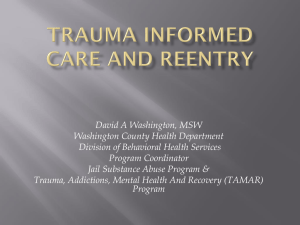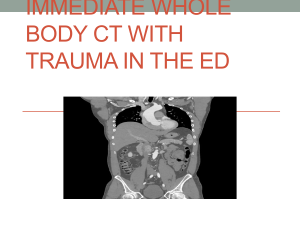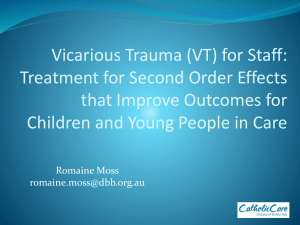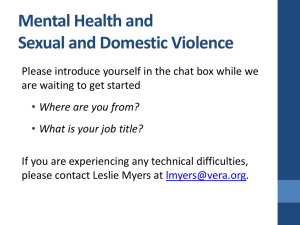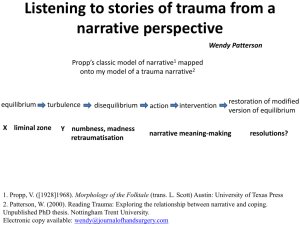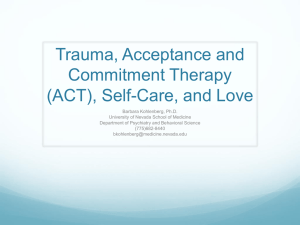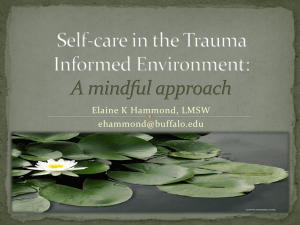Dr. Cassandra Kisiel`s presentation at this year`s NRCI Conference
advertisement
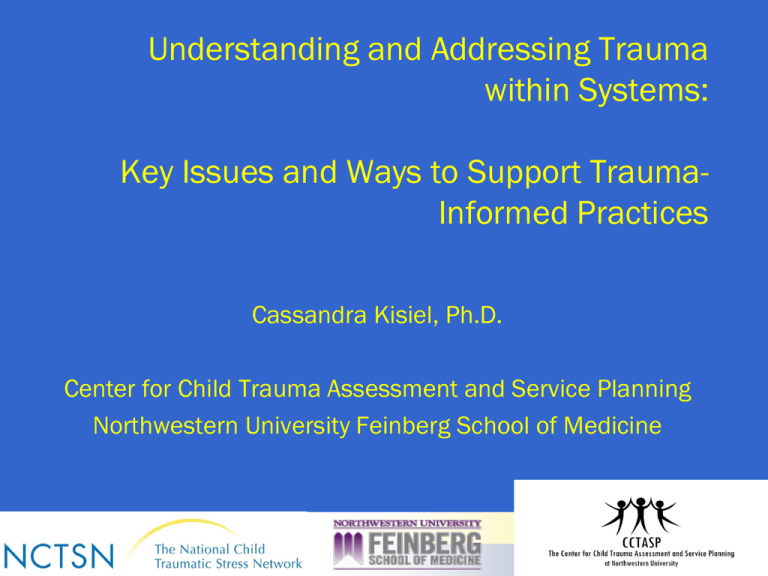
Understanding and Addressing Trauma within Systems: Key Issues and Ways to Support TraumaInformed Practices Cassandra Kisiel, Ph.D. Center for Child Trauma Assessment and Service Planning Northwestern University Feinberg School of Medicine The National Child Traumatic Stress Network (NCTSN) www.nctsn.org • Mission: To raise the standard of care and increase access to services for traumatized children and their families across the US • Established by Congress in 2000 • National collaboration of multiple academic and community-based service centers • Serves as a national resource for disseminating evidence-based interventions, trauma-informed services, and public and professional education • Emphasis on transforming trauma-focused services throughout childserving systems of care across the U.S. • Currently comprised of 176 member centers - including 79 currently funded Centers and 98 affiliate members Prevalence and Impact of Trauma • More than 67% of children/adolescents experience at least one potentially traumatic event before the age of 16. • 4 out of 10 U.S. children report witnessing violence; 8% report a lifetime prevalence of sexual assault; 17% report being physically assaulted. • The majority of traumatized children experience multiple, co-occurring, and often chronic forms of trauma or adverse experiences. • More than 60% of American males and 51% of females report lifetime exposure to one or more traumatic events; about 1 in 3 women will experience sexual assault in their lifetime. • Trauma impacts a broad range of areas for youth and adults: emotional, behavioral, interpersonal, physiological, and cognitive functioning. • Chronic interpersonal trauma in childhood has a differential impact on adults compared to acute or interpersonal traumas in adulthood. • Strengths have an important role in buffering the effects of trauma. A Common Theme for Systems Education Child Welfare Trauma Mental and Physical Health Juvenile Justice Substance Abuse The Impact of Trauma within Systems • Rates of maltreatment are significantly higher in juvenile detention and child welfare than in the general population. • Many youth and adults with trauma histories and current symptoms are never assessed or fully assessed. • Many youth with trauma symptoms never receive appropriate treatment. • Children and adults in both systems are sometimes “blamed” or labeled as “bad” = potential stigma • Both systems are largely comprised of already oppressed individuals who are often exposed to several other ongoing stressors. 50 45 Significant Traumatic Experiences for Youth entering Illinois Child Welfare (N=16,474) 40 35 30 25 20 15 10 5 0 Based on Kisiel et al. (2009). J Child and Adoles Trauma, 2:143-160 Complexly Traumatized Youth Entering IL Child Welfare Frequency of Significant Clinical Needs (N = 16,474) Single/Non-CG Trauma 25 Complex Trauma 20 15 10 5 0 *Complex Trauma Exposure = 2 or more significant caregiver traumas on the CANS All differences sig. at p=.000 Based on Kisiel et al. (2009). JCAT, 2:143160 Placement Disruptions by Type of Trauma Exposure: Two Years Following Entry into CW System (N=14, 264) 26% 15% 5% Single Type (Violent) Single Type (Non-Violent)** Illinois child welfare system, Incident Rate Ratios, **=p<.001 Kisiel et al., 2012 Multiple/Complex Trauma** Children’s Posttraumatic Reactions: Risk for Misdiagnosis and Mislabeling Children presenting with posttraumatic symptoms are at risk of being misdiagnosed with a variety of disorders and functional difficulties particularly when a trauma assessment is not conducted ADHD Depressive Disorders Oppositional Defiant Disorder Conduct Disorder Reactive Attachment Disorder Psychotic Disorders Specific Phobias Learning/ academic difficulties Juvenile Delinquency Challenges in the Assessment of Trauma Responses and within Service Systems- Misunderstood or Mislabeled? Willful defiance/noncompliance Intensely Reactive behaviors/ Sexually aggressive behaviors Psychotic Symptoms Trauma: A Missing Link? Conduct Disorder/ ‘Sociopathic’ behaviors Problems with Attention and Learning What is a Trauma-Informed Service System? • All programs/providers involved in a particular system recognize and respond to the impact of traumatic stress on all those who have contact with their system. • Programs and agencies within this system infuse and sustain trauma awareness, knowledge and skills to their organizational cultures, practices and policies • Programs and agencies act in collaboration with all those involved (using best available evidence) to facilitate and support resiliency of the child/adult and family. www.nctsn.org Trauma-Informed Practice The trauma-informed professional: • Understands the impact of trauma on a child or adult’s behavior, development, relationships, and survival strategies • Can integrate that understanding into planning for the child, adult, and family • Understands his or her role in responding to child traumatic stress NCTSN Child Welfare Trauma Training Toolkit, 2008 Resilience “The process of, the capacity for, or outcome of successful adaptation despite challenging or threatening circumstances.” (Masten, Best, & Garmezy, 1990) Protective Factors Protective factors can: 1. Buffer individuals from exposure to additional traumas or adversities 2. Increase the likelihood of positive outcomes following exposure to trauma. Individual Factors Protective Factors or Factors Promoting Resilience Developmental Competencies (language, cognitive skills) Personality and temperament Positive Beliefs/Self-efficacy Internal Locus of Control External Attributions for Blame Special Talents/Creativity Spirituality/Meaning-Making Environmental Factors Ongoing Social Support – within and outside of family Secure Attachments –Positive attachment with emotionally supportive adult Family Cohesion/Ties to Extended Family Community Involvement (recreational, religious) What can I D0 in my work? Helping to Support TraumaInformed Practices across Settings General Guidelines and Implications for Practice: How to Support Staff, Youth, and Caregivers • Recognize that exposure to trauma is often the rule, not the exception, among youth and adults in child welfare and justice settings. • Recognize the cumulative effects of trauma – the range of signs and symptoms stress and how they vary across different age groups. • Recognize that an individual’s “bad” behavior is sometimes an adaptation to trauma or a result of them not having developed age-appropriate regulation capabilities. Utilizing a Trauma-informed Perspective: Practical Recommendations (www.nctsn.org) 1. Routinely screen for trauma exposure and related symptoms 2. Conduct a comprehensive assessment – gathering information on all traumas and range of reactions to make better-informed decisions. 3. Integrate culturally appropriate and responsive evidence-based practices 4. Engage in efforts to strengthen the resilience and protective factors of children/families and adults impacted by trauma 5. Address parent trauma and its impact on the family system 6. Enhance communication/share resources with youth, adults, and providers on trauma exposure, its impact and treatment 7. Promote effective family involvement in counseling/rehab services. 8. Emphasize continuity of care and collaboration and training for ALL relevant professionals across child or adult service systems 9. Maintain an environment of care that addresses and minimizes secondary trauma and increases staff resilience Promoting resilience and building competence in the context of treatment and services • Strengthen ties to other adult/community resources • Teach flexible problem-solving skills – Communication skills – Self-help skills • Foster independence and responsibility • Strengthen and support individual competencies • Model/reward acts of cooperation and helpfulness June is National PTSD Awareness Month Why take time to learn about PTSD? • Because taking the step to help someone you care about (even yourself), or your clients, starts with knowing the basics. • No matter how much you already know about PTSD and trauma responses, there is always more to learn. • Initial step - connect with materials to help you learn more about PTSD, including the latest research and tools to manage symptoms See www.ptsd.va.gov for more information Provider Resources in Illinois: Statewide Provider Database (SPD) – https://illinoisoutcomes.dcfs.illinois.gov • Program Type – – – – – – – Mental Health Substance Abuse Domestic Violence Parenting Non-clinical Early Childhood General Medical • Target Population – Deaf/hard-of-hearing – Developmentally disabled – Young Children – Teen parents – Sexual offenders – Trauma survivors – GLBTQ – Foster care Information and Resources on Addressing Trauma: Helpful Organizations and Websites • National Child Traumatic Stress Network: www.nctsn.org (child) • National Center for PTSD: www.ptsd.va.gov (adult) • International Society for Traumatic Stress Studies: www.istss.org • American Professional Society on the Abuse of Children www.apsac.org • International Society for the Prevention of Child Abuse and Neglect www.ispcan.org • Illinois Statewide Provider Database https://illinoisoutcomes.dcfs.illinois.gov • Thank You! Contact Information: Cassandra Kisiel, Ph.D. c-kisiel@northwestern.edu


